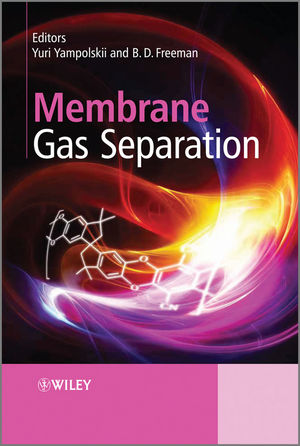Membrane Gas SeparationISBN: 978-0-470-74621-9
Hardcover
392 pages
September 2010
 This is a Print-on-Demand title. It will be printed specifically to fill your order. Please allow an additional 15-20 days delivery time. The book is not returnable.
|
||||||
Contributors.
I. Novel Membrane Materials and Transport in Them.
1 Synthesis and Gas Permeability of Hyperbranched and Cross-linked Polyimide Membranes (Shinji Kanehashi, Shuichi Sato and Kazukiyo Nagai).
1.1 Introduction.
1.2 Molecular Designs for Membranes.
1.3 Synthesis of Hyperbranched Polyimides.
1.4 Gas Permeation Properties.
1.5 Concluding Remarks.
References.
2 Gas Permeation Parameters and Other Physicochemical Properties of a Polymer of Intrinsic Microporosity (PIM-1) (Peter M. Budd, Neil B. McKeown, Detlev Fritsch, Yuri Yampolskii and Victor Shantarovich).
2.1 Introduction.
2.2 The PIM concept.
2.3 Gas Adsorption.
2.4 Gas Permeation.
2.5 Inverse Gas Chromatography.
2.6 Positron Annihilation Lifetime Spectroscopy.
2.7 Conclusions.
Acknowledgements.
References.
3 Addition-type Polynorbornene with Si(CH3)3 Side Groups: Detailed Study of Gas Permeation, Free Volume and Thermodynamic Properties (Yuri Yampolskii, Ludmila Starannikova, Nikolai Belov, Maria Gringolts, Eugene Finkelshtein and Victor Shantarovich).
3.1 Introduction.
3.2 Experimental.
3.3 Results and Discussion.
3.4 Conclusions.
References.
4 Amorphous Glassy Perfl uoropolymer Membranes of Hyfl on AD: Free Volume Distribution by Photochromic Probing and Vapour Transport Properties (Johannes Carolus Jansen, Karel Friess, Elena Tocci, Marialuigia Macchione, Luana De Lorenzo, Matthias Heuchel, Yuri P. Yampolskii and Enrico Drioli).
4.1 Introduction and Scope.
4.2 Membrane Preparation.
4.3 Free Volume Analysis.
4.4 Molecular Dynamics Simulations.
4.5 Transport Properties.
4.6 Correlation of Transport and Free Volume.
4.7 Conclusions.
References.
5 Modelling Gas Separation in Porous Membranes (Aaron W. Thornton, James M. Hill and Anita J. Hilli).
5.1 Introduction.
5.2 Background.
5.3 Surface Diffusion.
5.4 Knudsen Diffusion.
5.5 Membranes: Porous Structures?
5.6 Transition State Theory (TST).
5.7 Transport Models for Ordered Pore Networks.
5.8 Pore Size, Shape and Composition.
5.9 The New Model.
5.10 Conclusion.
List of Symbols.
References.
II. Nanocomposite (Mixed Matrix) Membranes.
6 Glassy Perfl uorolymer–Zeolite Hybrid Membranes for Gas Separations (Giovanni Golemme, Johannes Carolus Jansen, Daniela Muoio, Andrea Bruno, Raffaella Manes, Maria Giovanna Buonomenna, Jungkyu Choi and Michael Tsapatsis).
6.1 Introduction.
6.2 Materials and Methods.
6.3 Results and Discussion.
6.4 Conclusions.
Acknowledgements.
References.
7 Vapor Sorption and Diffusion in Mixed Matrices Based on Tefl on® AF 2400 (Maria Chiara Ferrari, Michele Galizia, Maria Grazia De Angelis and Giulio Cesare Sarti).
7.1 Introduction.
7.2 Theoretical Background.
7.3 Experimental.
7.4 Results and Discussion.
7.5 Conclusions.
Acknowledgements.
References.
8 Physical and Gas Transport Properties of Hyperbranched Polyimide–Silica Hybrid Membranes (Tomoyuki Suzuki, Yasuharu Yamada, Jun Sakai and Kumi Itahashi).
8.1 Introduction.
8.2 Experimental.
8.3 Results and Discussion.
8.4 Conclusions.
References.
9 Air Enrichment by Polymeric Magnetic Membranes (Zbigniew J. Grzywna, Aleksandra Rybak and Anna Strzelewicz).
9.1 Introduction.
9.2 Formulation of the Problem.
9.3 Experimental.
9.4 Results and Discussion.
9.5 Conclusions.
Acknowledgements.
List of Symbols.
References.
III. Membrane Separation of CO2 from Gas Streams.
10 Ionic Liquid Membranes for Carbon Dioxide Separation (Christina R. Myers, David R. Luebke, Henry W. Pennline, Jeffery B. Ilconich and Shan Wickramanayake).
10.1 Introduction.
10.2 Experimental.
10.3 Results.
10.4 Discussion.
10.5 Conclusions.
References.
11 The Effects of Minor Components on the Gas Separation Performance of Polymeric Membranes for Carbon Capture (Colin A. Scholes, Sandra E. Kentish and Geoff W. Stevens).
11.1 Introduction.
11.2 Sorption Theory for Multiple Gas Components.
11.3 Minor Components.
11.4 Conclusions.
References.
12 Tailoring Polymeric Membrane Based on Segmented Block Copolymers for CO2 Separation (Anja Car, Wilfredo Yave, Klaus-Viktor Peinemann and Chrtomir Stropnik).
12.1 Introduction.
12.2 Tailoring Block Copolymers with Superior Performance.
12.3 Block Copolymers and their Blends with Polyethylene Glycol.
12.4 Composite Membranes.
12.5 Conclusions and Future Aspects.
13 CO2 Permeation with Pebax-based Membranes for Global Warming Reduction (Quang Trong Nguyen, Julie Sublet, Dominique Langevin, Corinne Chappey, Stéphane Marais, Jean-Marc Valleton and Fabienne Poncin-Epaillard).
13.1 Introduction.
13.2 Experimental.
13.3 Results and Discussions.
13.4 Conclusions.
References.
IV. Applied Aspects of Membrane Gas Separation.
14 Membrane Engineering: Progress and Potentialities in Gas Separations (Adele Brunetti, Paola Bernardo, Enrico Drioli and Giuseppe Barbieri).
14.1 Introduction.
14.2 Materials and Membranes Employed in GS.
14.3 Membranes Applications in GS.
14.4 New Metrics for Gas Separation Applications.
15 Evolution of Natural Gas Treatment with Membrane Systems (Lloyd S. White).
15.1 Introduction.
15.2 Market for Natural Gas Treatment.
15.3 Amine Treaters.
15.4 Contaminants and Membrane Performance.
15.5 Cellulose Acetate versus Polyimide.
15.6 Compaction in Gas Separations.
15.7 Experimental.
15.8 Laboratory Tests of Cellulose Acetate Membranes.
15.9 Field Trials of Cellulose Acetate Membranes.
15.10 Strategies for Reduced Size of Large-scale Membrane Systems.
15.11 Research Directions.
15.12 Summary.
Acknowledgements.
References.
16 The Effect of Sweep Uniformity on Gas Dehydration Module Performance (Pingjiao Hao and G. Glenn Lipscomb).
16.1 Introduction.
16.2 Theory.
16.3 Results and Discussion.
16.4 Conclusion.
List of Symbols.
References.
Index.



